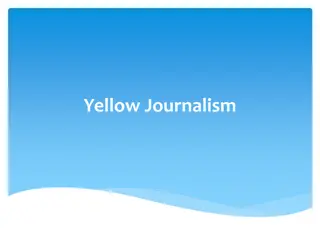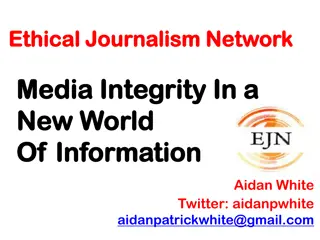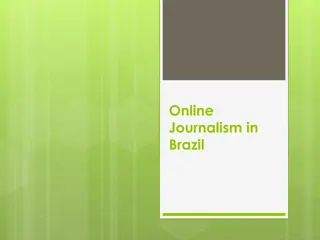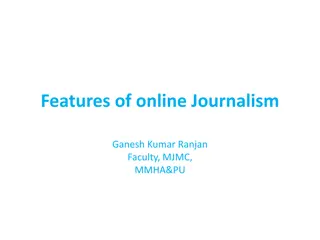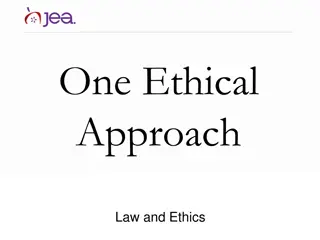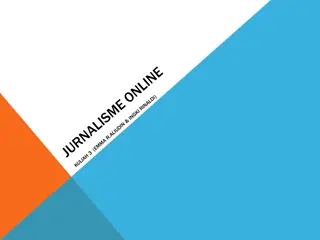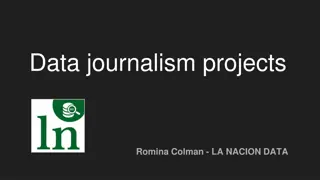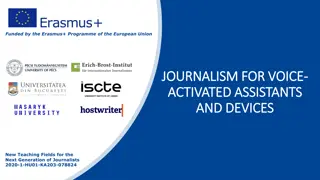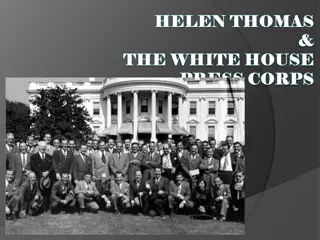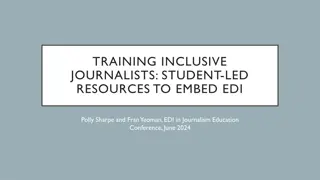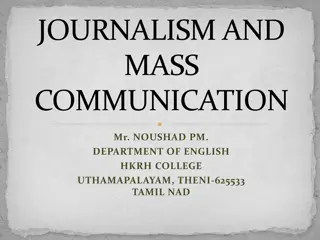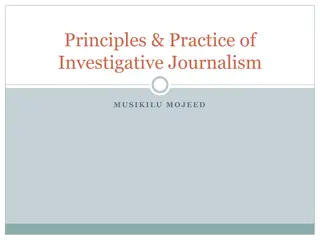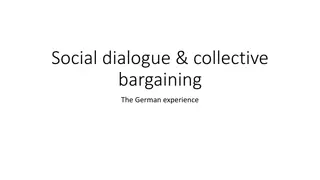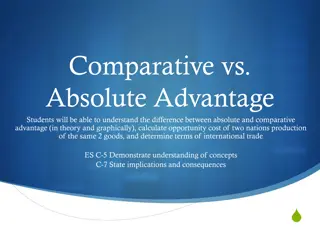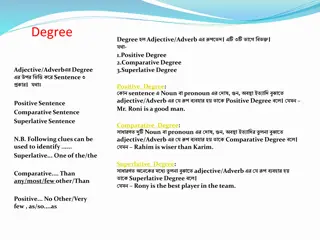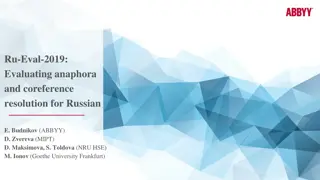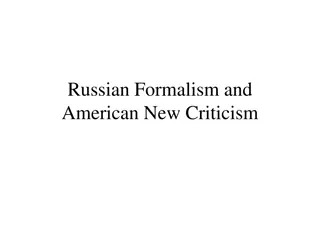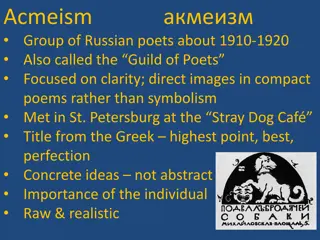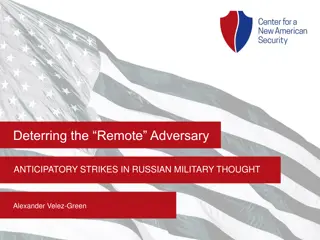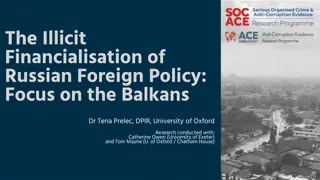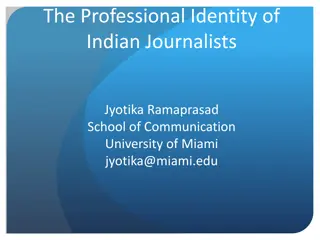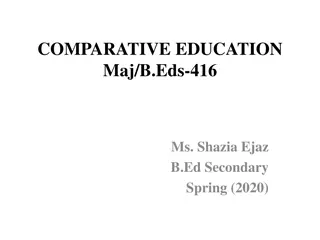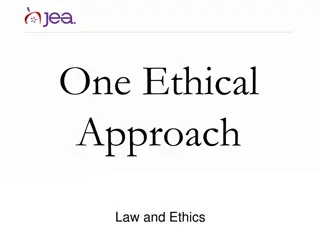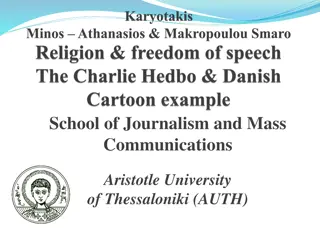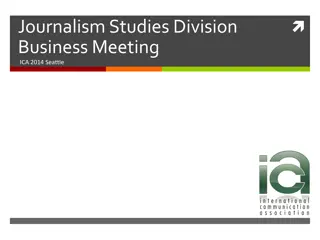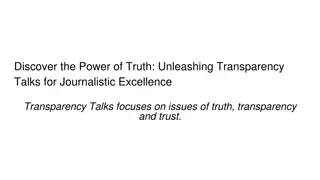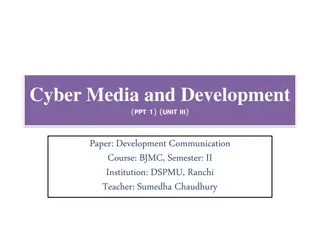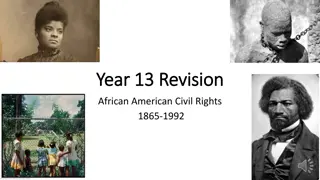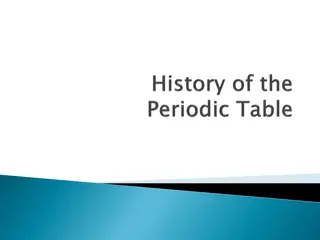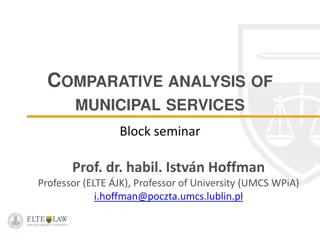Evolution of Russian Journalism: A Comparative Study from 1992 to 2008
The study examines the transformation of Russian journalism from the post-Soviet era through two surveys conducted in 1992 and 2008. It delves into changes in professional structures, job conditions, and orientations, shedding light on the historical contexts and regional representations. Primary data challenges are also highlighted, offering insights into the shifts from political enthusiasm to private interests in the journalistic landscape.
Download Presentation

Please find below an Image/Link to download the presentation.
The content on the website is provided AS IS for your information and personal use only. It may not be sold, licensed, or shared on other websites without obtaining consent from the author. Download presentation by click this link. If you encounter any issues during the download, it is possible that the publisher has removed the file from their server.
E N D
Presentation Transcript
Journalism in post-Soviet Russia: From political enthusiasm to private interest Svetlana Pasti, University of Tampere July11, 2010 Eichstaett, Germany
Questions How has Russian journalism changed in post- Soviet decades in professional structure? job conditions? professional orientations? 2 2 2
Method Two surveys: 1992 and 2008 1992 survey in the regions 2008 two stages: (1) Congress of Journalists in Sochi, (2) the regions Questionnaires based on Weaver s research with additional questions relevant to Russia Mixed technique of interviews 3 3
Conditions Primary data lacking on the number of media and journalists 1992 there were not hard data on media and working journalists (Zassoursky 1998) 2008 over 100,000 media outlets registered (Roskomnadzor 2008), but only a half of newspapers and magazines registered was really published (Russian Press Market 2009) 4 4
Regions 1992 ten regions representing the basic national geographic and socio-economic features 2008 thirty six cities from all six economic zones of the RF including big cities (1 million and over), middle sized cities (200-999 thousand) and smaller cities (under 200 thousand) with two capitals Moscow and St Petersburg 5 5
Respondents 1992 1000 respondents Full-time working journalists in press, radio and television providing information on general topics. 2008 800 respondents Full-time working journalists in press, radio and television, the internet media providing local news, political and economic issues, culture, leisure, youth topics 6 6
Historical context 1992 Atmosphere of liberalism. Political enthusiasm in the profession and society after Gorbachev s perestroika and glasnost, the collapse of communism and accessibility of the West. Euphoria from freedoms. Great expectations for happiness 2008 Atmosphere of etatism. Business enthusiasm, when the temptation of big money in the media market was not yet darkened by the global crisis. Political apathy, private interest. Media contracted by the state and business 7
Respondents: Age 1992 32%: under 35 2008 31%: under 30 25%: under 40 8 8
Two generations in 1992 Old (Soviet) generation came into Soviet media New generation came after 1991 9
Three generations in 2008 The Old (Soviet) generation (until 1992): 34% (267 journalists) Transitional generation (1992-1999): 31% (249 journalists) The New (Post-2000) generation: 34% (270 journalists) 10 10 10
Gender 1992 Male: 63% Female: 37% 2008 Male: 40% Females: 60% 11 11
Figure 1 Representation of men and women in generations of journalists in 2008 Entered profession in 2000 or later 32,6 67,4 Men Women Enter profession in 1992- 1999 38,5 61,5 Entered profession in 1991 or earlier 49,8 50,2 0% 10% 20% 30% 40% 50% 60% 70% 80% 90% 100% 12 12 12
Figure 2. Proportion of men and women in different media in 2008 Daily paper 45,5 54,5 Weekly paper 34,5 65,5 Weekly magazine 41,7 58,3 Monthly magazine 43,0 57,0 News agency 25,0 75,0 TV 40,0 60,0 Men Women Radio 43,8 56,3 Internent media 44,7 55,3 Press-service 32,0 68,0 Other paper 42,1 57,9 Other paper 46,7 53,3 Total 40,5 59,5 0% 10% 20% 30% 40% 50% 60% 70% 80% 90% 100% 13 13 13
Gender distributions in fields of coverage in 2008 Figure 3 50,4 49,6 Poliltics 46,3 53,8 Economy 41,4 58,6 Finance 46,2 53,8 Cars 30,0 70,0 Women's interest 33,3 66,7 Movies, TV 16,7 83,3 Popular music 72,0 28,0 Sports 100,0 ,0 Computers and high-tech 35,3 64,7 Repair and construction 33,3 66,7 Men's interest 25,0 75,0 Theater, musicl 33,9 66,1 Local news 25,6 74,4 Youth 43,5 56,5 Crime 40,0 60,0 Health 43,8 56,3 Famous and wealthy 50,0 50,0 Religious life 28,6 71,4 Travel 26,0 74,0 Advertisement 21,1 78,9 Family 100,0 ,0 Gardening 40,9 59,1 Culture, leisure 23,7 76,3 Consumer information 38,4 61,6 Other 0% 10% 20% 30% 40% 50% 60% 70% 80% 90% 100% 14 14 14
Education In 1992 highly educated 86%, among them 56% with journalism education In 2008 highly educated 86%, among them 44% with journalism education and 48% with other education 15
Salary in 1992 No clear data Significant part of the respondents could not answer to this question, because of inflation and changing payments, which, in turn were depending on subsidies from the state, circulations, bulk of advertising, support of sponsors and founders and the media own commercial services (Zassoursky 1998) 16 16
Salary level by employment in a second job in 2008 45,0 40,0 35,0 30,0 With a second job Without a second job Total 25,0 20,0 15,0 10,0 5,0 ,0 4 . rubles 4001- 6000 rubles 6001- 10000 rubles 10001- 20000 rubles 20001- 30000 rubles 30001- 40000 rubles 40001- 50000 rubles 50001- 60000 rubles 60001- 70000 rubles 70001- 80000 rubles 80000 rubles 17 17 17
Membership In 1992 member of journalistic unions: 60% In 2008 member of journalistic unions: 42%, among them the old generation: 76% and the new post-2000 generation: 17% 18
Motivation In 1992 three strongest reasons to go to journalism: an interesting work, freedom and independence of the media, and the political line of the media In 2008 a way of self-expression and self- realization, individual creativeness and wide communication including travelling 19
Job conditions Professional autonomy in newsroom Restrictions in job Satisfaction in job 20
Job conditions Professional autonomy in newsroom: I. If you get a good idea for a publication and you consider it is important, how often are you successful in realizing it, and to make a material? II. How independent are you in the selection of news, topics, problems of coverage? III. How independent are you in emphasizing ideas or aspects which in your opinion are important to your material? 21
I. If you get a good idea for a publication and you consider it is important, how often are you successful in realizing it, and to make a material? 22 22 22
II. How independent are you in the selection of news, topics, problems of coverage? 23 23 23
III. How independent are you in emphasizing ideas or aspects which in your opinion are important to your material? 24 24 24
How much are you independent in the selection of news, topics, problems of coverage? Independent depending on situation 35 % 29% 30 % 25 % 20 % 15 % 10 % 5% 5 % 0 % 2008 1992 25
How independent are you in emphasize those ideas or aspects which in your opinion are important to your material? Independent depending on situation 25 % 23% 20 % 15 % 10 % 6 % 5 % 0 % 2008 1992 26
Table 1 Restrictions in the job by generation factor in 2008 Restrictions: Cumulative % 1. local power: 29.4 Soviet generation Transitional generation New post-2000 generation 22.3 40.9 25.0 2.Interference of the boss: 23.0 3. Character of media audience: 19.4 4. Specialisation of the media: 16.5 5. Ethics: 14.6 23.9 21.7 23 20.1 19.3 18.9 10.8 17.2 21.5 18.1 17.6 8.7 6. Point of view of advertisers: 14.5 7.Political line of media: 13.7 8. Media owner: 9.9 8.5 18.0 16.6 16.2 11.1 14.0 8.5 11.5 9.8 9. Influence of the federal power: 7.1 10. Nothing: 5.5 10.4 8.2 2.6 4.6 3.3 8.3 11.Other: 3.9 4.6 5.7 1.5 12. Colleagues opinions: 3.4 2.7 2.9 4.2 27
Table 2 Barometer of Job satisfaction in 2008 Reasons for satisfaction Fully and chiefly satisfied in % 64.7 1. to independently decide how and what to write, to tell 2. to help people 64.2 3. Political line 60.1 4. Job security, social security 51.6 5. Opportunities for better qualification 51.1 6. to influence society 48.9 7. Opportunities for second job 48.4 8. Opportunities to grow in the post 42.1 9. Salary 38.8 10. for a career via journalism in politics, state service, business 37.7 11. Political independence of the profession 37.1 12. Extra privileges 36.7 28
Table 3 Job satisfaction by Generation in 2008 Soviet 1992 until Transitional 1992-1999 post- 2000 Reasons for satisfaction (fully and chiefly) % 1. to independently decide how and what to write, to tell 70.7 62.7 61.2 2. to help people 65.3 63.5 64.9 3. Political line 60.9 61.4 58.3 4. Opportunities for better qualification 50.2 48.7 55.1 5. to influence society 46.5 46.9 53.8 6. Opportunities for second job 44.8 48.0 52.8 7. Job security, social security 43.4 52.1 59.7 8. Opportunities to grow in the post 39.8 40.9 45.5 9. Salary 42.7 40.0 34.4 10. for a career via journalism in politics, state service, business 38.6 35.8 39.0 11. Political independence of the profession 34.0 32.4 44.9 12. Extra privileges 30.5 35.9 43.9 29
Working methods approved 30 30 30
Working methods approved 1) According to situation 31 31
Working methods approved 1) According to situation 32 32
Audience I. Our audience is more interested in news than analysis II. The majority of the audience has little interest in serious journalism III. Audience is gullible and easily deceived 33
I. Our audience is more interested in news than analysis 34 34
II. The majority of the audience has little interest in serious journalism 35 35
Audience 1992 reading nation, citizens participating in the political and social reforms 2008 TV watching nation, apolitical, consumers with individual plural interests in informational services, entertainment, advertising and goods. Moving into a private life 37 37
Conclusion Journalism becomes a profession for young and women Two thirds are post-Soviet generations Generation change is related to womanization: 67% among young It becomes a realm for the offspring of the middle class attracted with privileges for a second job and good income, glamour lifestyle, access to elite circles (elitization of journalism) 38 38
Conclusion From a wish to participate in democratic reforming via journalism in 1992 (political enthusiasm) to private interest/self-interest in the profession in 2008: creativity, self-realization, commerce, popular culture, personal promotion, political indifference 39 39
Conclusion Enthusiasm of 1992 shifted abstention from potential risks From adherent fighters for democracy in 1992 journalists turned into situational journalists observing corporate interests and business of their media organizations, their clients Post-2000 generation is the most satisfied in the profession 40 40
Conclusion Professional autonomy decreased but number of satisfied (over 60%) the same Probably owing to Situational factor Political conditions: to keep a low profile (fear of the state: local authorities and legal suits; editorial line) Obedient journalists under self-censorship Market ample offers: pursuit for profit Profession s habitus: second job, clientelism including corruption, atomization of community Personal strategies of success: mercenaries (pro-government media), artists (popular media) and experts (quality media) 41 41
Conclusion West is worried (Freedom House 2010: Russia is well- established authoritarian regime ) But Russian journalists not, majority are satisfied Towards the consolidation of professionals Money replaced freedom In one boat: Adaptation successfully took place 42
No need to rock the boat State capital Private capital Media tool Official Businessman Journalist Boat of prosperity 43
Role of Institutes in Russia (Levada Centre Survey, 2010) 2001 2005 2010 President 1 1 1 Oligarchs, bankers 2 2 3 Government 3 6 2 Media 4 4 8 Governors 5 8 9 Directors of big plants 6 10 14 Army 7 7 6 FSB 8 3 5 Sovet Federat. Upper Chamber P. 9 3 10 Church 10 11 12 Presidential Administration 11 5 4 Public prosecutor s office 12 9 7 State Duma 13 14 13 Court 14 12 11 Political parties 15 15 15 Intelligensia 16 16 16 44 Trade Unions 17 17 17




